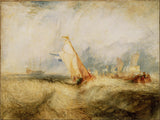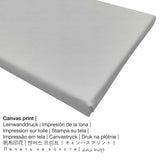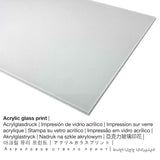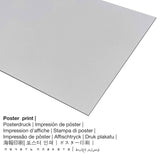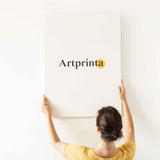Joseph Mallord William Turner, 1844 - Tromp - mbipụta nka mara mma
Ụtụ gụnyere. Mbupu gbakọrọ na ndenye ọpụpụ.
Banyere edemede a
The nkà nke oge a piece of art was painted by the male artist Joseph Mallord William Turner in 1844. Akụkụ nka a gụnyere na Ụlọ ihe ngosi nka nke J. Paul Getty nchịkọta nka dijitalụ na Los Angeles, California, Njikota Obodo Amerika. Site n'ikike nke Ụlọ ihe ngosi nka nke J. Paul Getty (ọha na eze).In addition to that, the artwork has the creditline: . What is more, the alignment is odida obodo ma nwee oke onyonyo nke 4: 3, nke pụtara na ogologo bụ 33% ogologo karịa obosara. Joseph Mallord William Turner was a painter, whose style can be attributed primarily to Romanticism. The British painter lived for 76 years - born in the year 1775 na London, Greater London, England, United Kingdom wee nwụọ na 1851.
Họrọ ihe ngwaahịa gị
Anyị na-enye ụdị dị iche iche nha na ihe maka ngwaahịa ọ bụla. Anyị na-ahapụ gị ka ịhọrọ n'ime ụdị ndị a:
- Mpempe akwụkwọ (ihe kwaaji): The Artprinta poster is a printed sheet of flat canvas with a granular surface finish, which resembles the actual artwork. It is suited for putting the fine art print with a custom-made frame. Please note, that depending on the size of the poster we add a white margin 2-6 cm round about the print in order to facilitate the framing.
- Mbipụta kanvas: A canvas print, not to be confused with a real artwork painted on a canvas, is a digital replica applied onto cotton canvas fabric. A canvas creates the distinctive impression of three dimensionality. Canvas Prints have the advantage of being relatively low in weight, which implies that it is quite simple to hang the Canvas print without the use of additional wall-mounts. A canvas print is suited for all types of walls.
- Glass acrylic e biri ebi (nwere ezigbo mkpuchi iko): An print on acrylic glass, which is sometimes described as a fine art print on plexiglass, makes the original artwork into beautiful home décor. The great benefit of an acrylic glass art print is that contrasts plus smaller artwork details become more visible due to the fine tonal gradation of the print. The acrylic glass protects your custom art print against light and external influences for several decades.
- Metal (aluminium debond mbipụta): Aluminium Dibond prints are metal prints with an outstanding depth. For your Aluminium Dibond option, we print the artpiece on the surface of the white-primed aluminum. This direct print on aluminium is the most popular entry-level product and is a truly sophisticated way to showcase fine art prints, as it draws attention on the image.
Ozi dị mkpa: We try everything in order to describe our art products in as much detail as possible and to exhibit them visually. Although, the tone of the printing material and the imprint might differ marginally from the representation on your screen. Depending on your screen settings and the quality of the surface, not all colors can be printed as exactly as the digital version depicted here. Because the are printed and processed by hand, there might also be minor discrepancies in the exact position and the size of the motif.
Nkọwa ihe ahaziri ahazi
| Bipụta ngwaahịa: | nka nka |
| Usoro mmeghari: | dijitalụ mmeputakwa |
| Produzọ mmepụta: | Mbipụta UV ozugbo (mbipụta dijitalụ) |
| Mmalite nke ngwaahịa a: | German mere |
| Ụdị ngwaahịa: | a na-achọ |
| A na-atụ aro iji ngwaahịa eme ihe: | gallery ebipụta nka, imewe ụlọ |
| Ndepụta: | usoro odida obodo |
| Ụdị anya: | 4: 3 |
| Mmetụta nke akụkụ akụkụ: | ogologo bụ 33% ogologo karịa obosara |
| Akụrụngwa dị: | Mbipụta iko acrylic (nwere ezigbo mkpuchi iko), mbipụta ọla (aluminium dibond), mbipụta akwa akwa, mbipụta akwụkwọ mmado (akwụkwọ kwaaji) |
| Ọdịiche dị n'okirikiri akwa akwa akwa (akwa akwa): | 40x30cm - 16x12", 80x60cm - 31x24", 120x90cm - 47x35", 160x120cm - 63x47" |
| Mbipụta iko acrylic (nke nwere ezigbo mkpuchi iko): | 40x30cm - 16x12", 80x60cm - 31x24", 120x90cm - 47x35", 160x120cm - 63x47" |
| Mpempe akwụkwọ mmado (akwụkwọ kwaaji) nha: | 40x30cm - 16x12", 80x60cm - 31x24", 120x90cm - 47x35" |
| Mbipụta aluminom: | 40x30cm - 16x12", 80x60cm - 31x24", 120x90cm - 47x35" |
| Igwe onyonyo: | ngwaahịa anaghị emebi emebi |
Ozi nka
| Akụkụ nka: | "Tromp" |
| Nhazi nka: | sere |
| Okwu mkpokọta: | nkà nke oge a |
| Nhazi oge: | 19th narị afọ |
| Emepụtara n'afọ: | 1844 |
| Afọ nka: | karịa afọ 170 |
| Egosiputara na: | Ụlọ ihe ngosi nka nke J. Paul Getty |
| Ebe ngosi nka: | Los Angeles, California, Njikota Obodo Amerika |
| Weebụsaịtị ihe ngosi nka: | Ụlọ ihe ngosi nka nke J. Paul Getty |
| Akwụkwọ ikike nka: | ngalaba ọha |
| Site n'aka: | Ụlọ ihe ngosi nka nke J. Paul Getty |
Ozi omenkà Contextal
| Aha onye nka: | Joseph Mallord William Turner |
| Aha ndị ọzọ: | joseph m. w. turner, Turner J.M.W. (Joseph Mallord William), I.W.M. Turner RA, Turner J. M. W., J. W. Turner, I.M.W. Turner, J. M. W. Turner, Joseph Mallord William Turner, Turner Joseph Mallord William, J.W.M. Turner RA, J.M.W. Turner RA, J.M.W. Turner R.A., טרנר ג'וזף מאלורד ויליאם, turner j.m.w., jmw turner, Turner J M. W., J.M.W. (Joseph Mallord William) Turner, j.m.w. turner, Tʻou-na, j. m. w. turner r. a., W. Turner, Tʻou-na Yüeh-se-fu Ma-lo-te Wei-lien, Turner Joseph Mallord William, Tarner Tzozeph Mallornt Ouilliam, Turner R.A., Turner RA, טרנר ג׳וזף מאלור ויליאם, Tŭrnŭr Dzhouzef Mŭlord Uili︠a︡m, Terner Dzhozef Mallord Uilʹi︠a︡m, W. M. Turner R.A., J. M. W. Turner R. A., J.W.M. Turner R.A., Turner J.M.W., Turnor, Turner William, Turner, Turner James Mallord William |
| okike nke onye nka: | nwoke |
| Obodo onye nka: | British |
| Ọrụ nke onye na-ese ihe: | onye na-ese ihe |
| Country: | United Kingdom |
| nhazi ọkwa: | omenkà nke oge a |
| styles: | Ihunanya |
| Ndụ: | 76 afọ |
| Amụrụ n'afọ: | 1775 |
| Ebe amụrụ onye: | London, Greater London, England, United Kingdom |
| Afọ nwụrụ: | 1851 |
| Ebe ọnwụ: | Chelsea, London, Greater London, England, United Kingdom, agbataobi |
© nwebiisinka site na - www.artprinta.com (Artprinta)
General description from the museum's website (© Copyright - by The J. Paul Getty Museum - www.getty.edu)
In this narrative history painting, Joseph Mallord William Turner expressed the power of nature and the heroism of man through the eyes of a Romantic painter. Turner used quick, slanting brushstrokes to describe the stormy sky. The application of scumbled white paint suggests churning, turbulent seas and the heavy spray of waves hitting the ship's bow. Tones of brown paint near the bottom of the canvas give a sense of the sea's violent power.
On the foredeck of a ship that strains against the waves, a man stands in a white uniform and waves with confidence. While scholars are uncertain of the exact historical event Turner described, one probable interpretation is that the man depicted here is Dutch naval officer Cornelis Van Tromp, who was dismissed from naval service in 1666 after failing to follow orders. Van Tromp was reinstated in service and reconciled with his navy superiors in 1673. In perhaps a symbolic overture signaling his submission to authority, Tromp is shown, in Turner's words, "going about to please his Masters."

